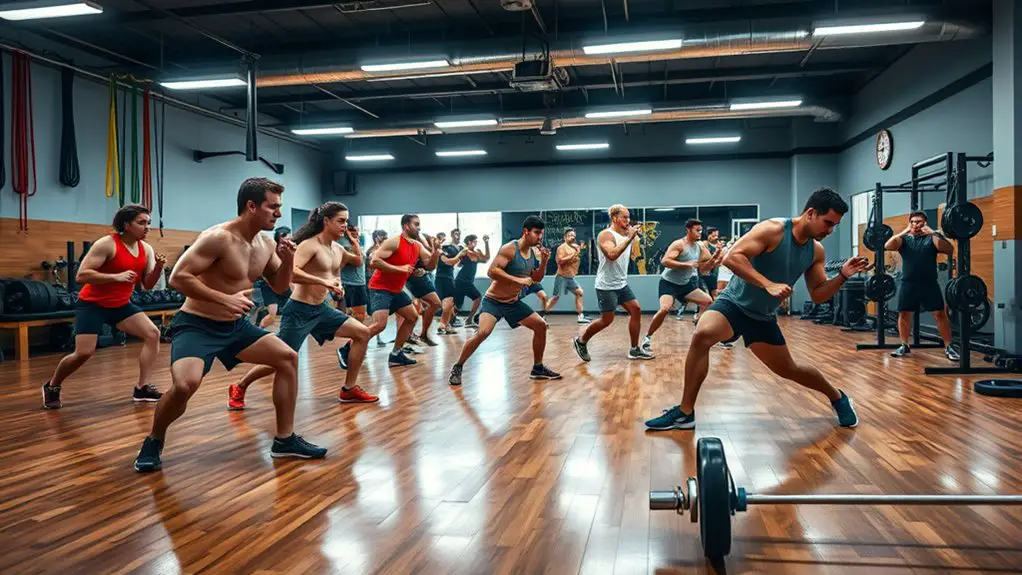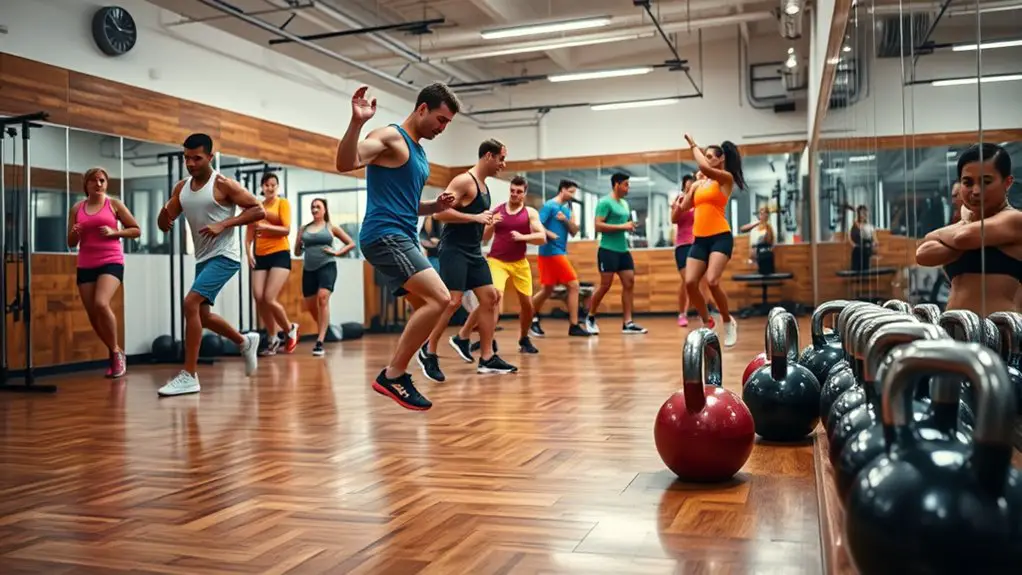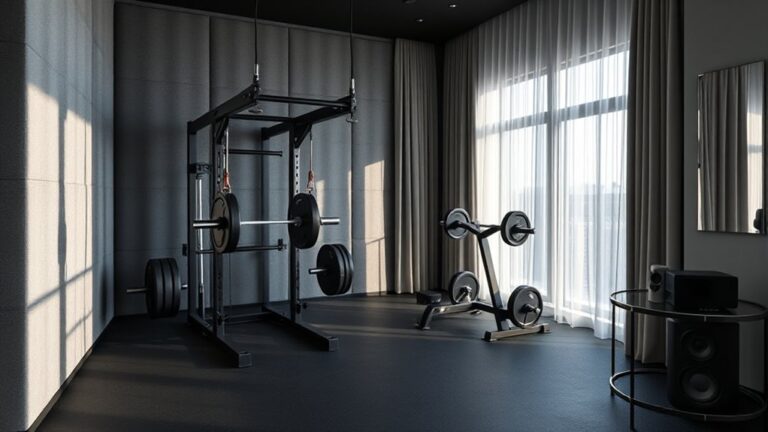The Best Gym Warm-Ups for Heavy Lifting Sessions

Warming up before heavy lifting is key to enhancing your performance and preventing injuries. Start with 5-10 minutes of dynamic stretching to loosen up your muscles. Incorporate mobility drills for your joints and activation exercises for key muscle groups. Add in some cardiovascular warm-ups to elevate your heart rate. Remember, customizing your routine to fit your needs can make a big difference. Stick around to discover more effective strategies for maximizing your workouts!
The Importance of Warming Up Before Heavy Lifting

Although it might be tempting to jump straight into your heavy lifting routine, taking the time to warm up is essential for both performance and safety. Warming up effectively prepares your muscles, improving blood flow and increasing flexibility. This enhances your overall strength and endurance during your workout.
One of the key benefits of warming up is injury prevention. By gradually increasing your heart rate and loosening your muscles, you reduce the risk of strains and sprains. It’s not just about lifting heavier; it’s about lifting smarter. A proper warm-up helps your body adapt to the demands of heavy lifting, allowing you to perform at your best while minimizing the likelihood of setbacks.
Dynamic Stretching: Preparing Your Muscles
To maximize the benefits of your warm-up, incorporating dynamic stretching can be a game-changer. This technique not only enhances your dynamic flexibility but also primes your muscles for the heavy lifting ahead. By engaging in movements that mimic the exercises you’ll be doing, you prepare your body effectively. Think leg swings, arm circles, and walking lunges—these exercises activate your muscle groups and promote blood flow.
Dynamic stretching helps improve muscle readiness, allowing for greater range of motion and reduced risk of injury. It’s essential to focus on controlled movements that gradually increase in intensity. Aim for 5 to 10 minutes of dynamic stretching to fully awaken your muscles and joints. As you incorporate this into your routine, you’ll notice improved performance and strength during your lifting sessions. So, get moving and feel the difference dynamic stretching can make!
Mobility Drills for Joint Health

Incorporating mobility drills into your warm-up routine can greatly enhance joint health and overall performance. These drills focus on improving joint mobility, making your flexibility routines more effective and reducing the risk of injury. Here are four essential mobility drills to include:
- Hip Circles: Stand on one leg and move the opposite knee in a circular motion, promoting hip joint mobility.
- Thoracic Spine Rotations: With your hands behind your head, rotate your upper body side to side to enhance spinal mobility.
- Ankle Dorsiflexion: While standing, bend one knee and push it forward over your toes, improving ankle flexibility.
- Shoulder Dislocates: Using a resistance band, hold it wide and raise it over your head and back, opening up the shoulder joints.
Incorporate these drills consistently, and you’ll notice significant improvements in your performance and overall joint health.
Activation Exercises for Key Muscle Groups
Before you plunge into heavy lifting, it’s crucial to activate key muscle groups to assure peak performance and prevent injury. Activation exercises enhance muscle engagement and confirm you’re properly warmed up for the challenges ahead. Focus on targeted activation of muscle groups like glutes, core, and shoulders. Here’s a quick guide to effective activation exercises:
| Muscle Group | Activation Exercise |
|---|---|
| Glutes | Glute bridges |
| Core | Plank variations |
| Shoulders | Band pull-aparts |
| Hamstrings | Single-leg deadlifts |
| Quadriceps | Wall sits |
Incorporating these exercises into your warm-up routine boosts your overall strength and stability. It primes your muscles for heavy lifting, helping you lift more efficiently and safely. Remember, a strong foundation is crucial for achieving your lifting goals!
Cardiovascular Warm-Up Techniques

A solid cardiovascular warm-up is essential for getting your heart rate up and preparing your body for heavy lifting. To maximize your warm-up duration, aim for at least 5-10 minutes of moderate cardio intensity. Here are some effective techniques you can incorporate:
- Jump Rope: It’s a great way to elevate your heart rate quickly and improve coordination, while also serving as an effective cardio workout that can contribute to weight loss.
- Brisk Walking or Jogging: Start slow, gradually increasing your pace to raise your body temperature.
- Cycling: Whether on a stationary bike or outdoors, cycling is low-impact and effective.
- Dynamic Stretching: Combine movement with stretching to enhance your range of motion while warming up.
Sport-Specific Movements to Enhance Performance
When it comes to enhancing your performance, incorporating sport-specific movements is key. Dynamic stretching techniques and mobility drills not only prepare your muscles but also improve your range of motion. By focusing on sport-specific activation exercises, you’ll prime your body for the demands of heavy lifting, ensuring you maximize your potential.
Dynamic Stretching Techniques
Dynamic stretching techniques are essential for optimizing your performance during heavy lifting sessions. Incorporating them into your dynamic warm-up enhances flexibility training and prepares your body for the demands of heavy lifts. Here are four effective dynamic stretching exercises to include:
- Leg Swings: Stand on one leg and swing the opposite leg forward and backward to loosen your hips.
- Arm Circles: Extend your arms and rotate them in circles, gradually increasing the size to warm up your shoulders.
- Walking Lunges: Step forward into a lunge, alternating legs to engage your lower body.
- High Knees: Jog in place, bringing your knees up toward your chest to increase heart rate and activate your core.
These movements will make a significant difference in your lifting performance!
Mobility Drills Importance
Incorporating mobility drills into your warm-up routine is a game changer for enhancing performance in heavy lifting. These drills not only improve joint flexibility but also offer significant mobility benefits that can lead to better lifting mechanics and reduced injury risk. By focusing on sport-specific movements, you prepare your body more effectively for the demands of your workout.
| Mobility Drill | Benefits |
|---|---|
| Hip Circles | Enhances hip flexibility |
| Arm Swings | Improves shoulder mobility |
| Ankle Rolls | Increases ankle stability |
| Thoracic Rotations | Boosts upper back mobility |
Integrating these exercises will elevate your performance, ensuring you lift heavier with better form. Embrace mobility drills, and watch your gains soar!
Sport-Specific Activation Exercises
To maximize your performance during heavy lifting, incorporating sport-specific activation exercises into your warm-up routine is essential. These targeted exercises help prepare your muscles and nervous system for the demands of your sport, enhancing overall effectiveness. Here are some effective activation techniques to reflect on:
- Dynamic lunges – Engage your hip flexors and quads.
- Banded lateral walks – Activate your glutes and improve stability.
- Push-up variations – Strengthen your chest, shoulders, and core.
- Medicine ball slams – Develop explosive power and coordination.
Cool-Down Routines to Aid Recovery
After a heavy lifting session, your cool-down routine is just as essential as your warm-up. Incorporating effective stretching techniques, staying hydrated, and engaging in active recovery can greatly boost your recovery process. Let’s explore how these elements can enhance your overall performance and well-being.
Stretching Techniques for Recovery
Although many focus on the intensity of their workouts, neglecting the cool-down phase can hinder your recovery. Incorporating stretching techniques is essential for ideal recovery and reducing muscle soreness. Here are four effective methods:
- Static Stretching: Hold stretches for 20-30 seconds to lengthen your muscles and promote flexibility.
- Foam Rolling: Use a foam roller to release muscle tightness and improve blood flow.
- Deep Breathing: Practice deep, controlled breaths to relax your body and mind after intense sessions.
- Gentle Movement: Engage in light activities, like walking, to gradually lower your heart rate and aid recovery.
Importance of Hydration
Staying properly hydrated during your workout is essential, as it not only enhances performance but also plays a significant role in your recovery process. Proper hydration helps in muscle repair, reduces fatigue, and prevents cramps. Here are some hydration tips to maximize your benefits:
| Hydration Tips | Hydration Benefits |
|---|---|
| Drink water before, during, and after workouts | Improves endurance and strength |
| Use electrolyte drinks for intense sessions | Replenishes lost minerals |
| Monitor urine color for hydration levels | Clear indicates good hydration |
| Set reminders to drink water | Consistent hydration boosts recovery |
| Carry a water bottle | Makes it easier to stay hydrated |
Active Recovery Recommendations
To guarantee your body recovers effectively after heavy lifting, incorporating an active cool-down routine is essential. Active recovery techniques help reduce soreness and improve flexibility. Here are four effective methods you can use:
- Light Cardio: Engage in 5-10 minutes of low-intensity activities like walking or cycling to promote blood flow.
- Static Stretching: Focus on the major muscle groups you’ve worked, holding each stretch for 20-30 seconds.
- Foam Rolling: Utilize foam rolling to release muscle tension; the foam rolling benefits include enhanced recovery and reduced muscle stiffness.
- Hydration: Replenish fluids lost during your workout to aid recovery and maintain overall performance.
Implementing these strategies will optimize your recovery and prepare you for your next lifting session.
Tips for Customizing Your Warm-Up Routine
When you’re gearing up for heavy lifting, customizing your warm-up routine can make a significant difference in your performance and safety. Start by evaluating your individual preferences; some people thrive with dynamic stretches, while others might prefer lighter weights or mobility exercises. Consider your specific lifting goals and the muscles you’ll be targeting that day.
Next, focus on warm-up duration. Typically, you should aim for about 10 to 15 minutes, but adjust this based on your unique needs. If you’re feeling tight or stiff, extending your warm-up might be beneficial. Integrate movements that mimic the lifts you’ll be performing, gradually increasing intensity.
Finally, listen to your body. If something doesn’t feel right, modify your routine accordingly. A tailored warm-up not only enhances your performance but also helps prevent injury, setting the tone for a successful lifting session.
Frequently Asked Questions
How Long Should My Warm-Up Last Before Heavy Lifting?
Think of your warm-up like revving a car engine before a race. You wouldn’t just slam on the gas without checking under the hood! Ideally, your warm-up should last about 10 to 15 minutes, adjusting the intensity to prepare your muscles and joints for heavy lifting. This duration allows your body to gradually increase blood flow and flexibility, reducing the risk of injury, and ensuring you’re ready to perform at your best.
Can I Skip Warm-Ups if I’m Short on Time?
You might think skipping warm-ups saves time, but it can hurt your workout efficiency. Proper warm-ups boost blood flow and prepare your muscles, helping prevent injuries. If you’re short on time, consider a quick, dynamic warm-up that lasts just 5-10 minutes. This approach enhances your time management while ensuring you’re ready for your workout. Remember, investing a bit of time in warming up pays off in better performance and safety during your heavy lifting sessions.
What Should I Avoid During My Warm-Up Routine?
Think of your warm-up as the bridge connecting you to your fitness goals. To cross it safely, avoid static stretches; they can lock your muscles in place, hindering the mobility you need. Also, steer clear of pushing too hard—overexertion risks can lead to injuries that derail your progress. Instead, focus on dynamic movements that awaken your body, preparing it for the challenges ahead while keeping you energized and ready to lift.
Is It Necessary to Warm up Every Workout Session?
Yes, it’s necessary to warm up every workout session. Warming up prepares your body, enhancing performance and reducing injury risk. The benefits of warming include increased blood flow and improved flexibility. You can use warm-up techniques like dynamic stretches and light cardio to engage your muscles effectively. By making it a habit, you’ll boost your overall workout experience and guarantee you’re ready to tackle those challenging exercises with confidence and safety.
Can Warm-Ups Prevent Injuries During Heavy Lifting?
Absolutely, warm-ups can be your ultimate shield against injuries when you’re lifting heavy! Imagine stepping onto the gym floor like a superhero, ready to conquer the weights. The benefits of warming up go beyond just getting your blood flowing; they prime your muscles and joints, enhancing mobility and stability. By incorporating a solid warm-up routine, you greatly boost injury prevention, allowing you to lift heavier and achieve your goals with confidence!





